This article is an objective analysis of how to greatly improve the Merseyrail Metro Network easily and cheaply, to serve the people of Greater Liverpool.
LIVERPOOL HAS RAPID TRANSIT UNDERGROUND RAIL EXTENSIONS WAITING TO BE USED
Liverpool has nearly 4 miles of disused rail tunnel under its centre and inner city.
Wapping Tunnel: 1.26 miles: 2.03 km Waterloo Tunnel: 2.07miles: 3.34 km Dingle Tunnel: 0.5 miles: 0.8 km
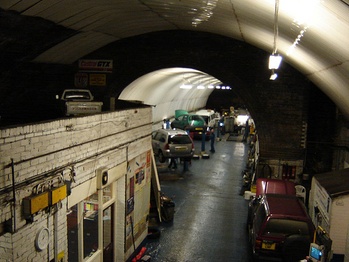 Dingle Underground Station is Intact Liverpool has two underground stations awaiting re-commissioning, Dingle and St James' at Parliament Street, and provision for another two in underground tunnel cuttings, Byrom Street and the Cavendish Cutting.
Dingle Underground Station is Intact Liverpool has two underground stations awaiting re-commissioning, Dingle and St James' at Parliament Street, and provision for another two in underground tunnel cuttings, Byrom Street and the Cavendish Cutting.
Merseyrail is a hybrid metro/commuter rail system. To make the network into a full metro more stations are required in Liverpool's city centre and inner-city districts. The inner-city districts are poorly served by Merseyrail. Merseyrail has the potential to be the most comprehensive "metro" network underground/overground, an S-Bhan, in the UK in relation to its population. If all the disused lines, trackbed, stations and tunnels are brought back into use and seamlessly merged, Merseyrail will cover more than London's Underground in percentage terms of its served population.
Manchester wanted an underground rapid transit rail system, dismissing the idea on cost. Unfortunately the city reverted to trams. Liverpool has a rapid transit underground system, with an abundance of disused underground rail infrastructure awaiting re-use creating a full metro network, yet the city bizarrely proposed a tram system. The tram system was cancelled by the government in 2006.
The tram system was cancelled. The transport minister in October 2009 stated there will be no funding for the tram scheme effectively killing the project.
If Merseytravel had the vision to extend Merseyrail in the city centre, and present a case for the inner-city districts with whole region connectivity, we may have seen the construction of Merseyrail extensions. This lack of focus and ambition has resulted in he the Liverpool City Region suffering.
Top class cities around the world have rapid-transit underground rail networks as the prime means of transport. The are the oil in making these cities operate effectively. Liverpool can easily extend its underground/overground metro network to be highly comprehensive and the envy of European cities of similar population.
Merseyrail has in underground rail:
-
Five 100% underground stations
-
Three underground stations in tunnels with the roof open to the atmosphere
-
One station at the end of tunnels (viewed as partial underground station)
-
One disused 100% underground station
-
One disused underground station with the roof open to the atmosphere
-
At least one station can be built into tunnel vent cuttings (viewed as underground)
-
Stations can be cut into tunnels - e.g., an essential station for the Royal Liverpool Hospital
-
There are four underground tunnels awaiting re-commission in Liverpool and Birkenhead centres/inner-city
-
There are various other disused tunnels: Kirkdale station to Queens Drive/Rice Lane, Sandhills to Sandon Dock and under Linacre Gas Works
That is 11 underground stations used or easily re-commissioned, which would be 14 if two essential stations are cut into the tunnels at the University and the Royal Hospital, and around 5 miles of underground tunnel awaiting reuse. Underground railways are fast and do not interfere with surface buildings and traffic.
DfT Knows Nothing of The Tunnels
The Department for Transport in Westminster, regarding the re-use of the near five miles of tunnels under Liverpool, has stated, "No such discussions with Merseytravel have taken place".
Merseytravel Unfocused
Merseytravel's have not focused on what is important to project the city forwards in transport. They have wasted ten years focusing on a cancelled tram scheme, when they should have been primarily focusing on extending Merseyrail and recommissioning the disused tunnels under the city. Merseytravel need informing or reminding of what the city has in infrastructure, and how to use what is ready and waiting under the streets. They appear unable to focus on what is essential to project the city forwards in transport infrastructure. City mayors and metro-mayors appear to not value the rail infrastructure and what it can do to project the city forwards.
The easy route is invariably taken in implementing Merseyrail extensions, by small extensions on the extreme peripherals of the network. Extensions to: Skelmersdale, Burscough Curves, and Helsby are all in focus. Although these are very nice to have on the network, the city centre and inner city districts needs full focus as this is where the need clearly is. Great social benefits would be gained by extending Merseyrail in the city centre. Full value can be given by using existing disused rail infrastructure. Further focus should be on discouraging cars from entering the city centre. Mersey Tunnel tolls do help here in keeping down cars flooding into the city from the Wirral. Removing The Strand road, which is the only section implemented of the discredited 1960's Shankland plan inner motorway is another way of taking cars away from the city centre. It is more an urban motorway, together with the Dock Road where it runs from the Pier Head to Parliament Street. These roads act as barriers between the attractive docks and the city, and are no longer are needed to serve goods to and from the docks.
Merseytravel appear to have lost the plot over the decades with a needless tram scheme and phaffing about on the network peripherals proves this point. In the past 10 years little has been realised in Liverpool in rapid-transit rail. A new station again at the peripherals, at Maghull North is hardly encouraging.
Underground Circle Hub Line Mainly Intact to Re-use
 Circle Line - a 1913 map used as rail lines are clear The city is far bigger than the map in area. All the Liverpool area shown on the map is now built on.
Circle Line - a 1913 map used as rail lines are clear The city is far bigger than the map in area. All the Liverpool area shown on the map is now built on.
-
The proposed Circle Hub Line loop line is in blue
-
The blue & pink lines are existing disused tunnels
-
The blue & green line is predominantly cut and cover not tunnelling.
-
The blue line only is existing used line.
-
Tunnelling where cut and cover meets existing tunnels.
-
The red is the existing unused Wapping tunnel, which is not on the Circle Line. This can be used to link the Wirral with Edge Hill and beyond if need be.
-
The new stations are marked
-
The long blue/pink line is the disused Waterloo Tunnel
-
The spur to the south is nice to have bringing in two districts onto the Merseyrail by diverting the Northern Line. It is not part of the proposed Circle Line. It is easily done by cut & cover across parkland and down a duel carriageway
It is easy to see the great enhancement The hub makes to the city's underground. Approximately 80% of the Circle Hub is already in place in the form of existing used lines and disused tunnels. It would create superb seamless connectivity all over the Liverpool region, especially when Liverpool John Lennon airport receives a station.
An Underground Circle Hub Line is Cheap
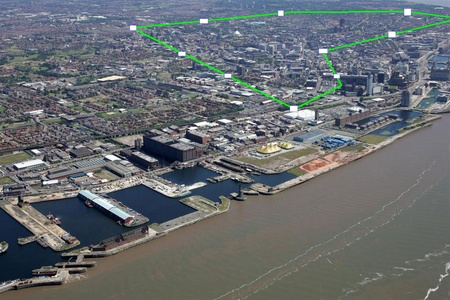 Circle Line Coverage Expensive periphery stations of Merseyrail should be second tier objectives. Focus should be on extending the existing rapid transit underground system in the city centre and inner city districts. This will project the city forwards. This Circle Hub Line should be the first phase. Trams, or tram-trains can add value as fillers on the outskirts of the city, where there are gaps in Merseyrail coverage.
Circle Line Coverage Expensive periphery stations of Merseyrail should be second tier objectives. Focus should be on extending the existing rapid transit underground system in the city centre and inner city districts. This will project the city forwards. This Circle Hub Line should be the first phase. Trams, or tram-trains can add value as fillers on the outskirts of the city, where there are gaps in Merseyrail coverage.
The Dingle Tunnel is half a mile long complete with an underground station. How much would it cost these days to bore that tunnel and build the station? £400 million? It is there for virtually free
There are two underground stations awaiting re-commission and one station can be accommodated in the Waterloo Tunnel in a wide cutting at Byrom St. Other stations can be cut into tunnels and others left behind when cut & cover tunnelling forming a Hub.
This new tunnel section would run from Dingle through Lodge Lane regenerating two inner-city areas. Underground stations being introduced in London have been a great catalyst for regeneration. The benefits are obvious.
The city centre could have an outer city centre underground Circle Line for a knock-down price, by constructing a section of tunnel, which would be mainly cut & cover over parkland to complete the circle. This only uses one of the long disused tunnels from Edge Hill, the Waterloo Tunnel.
The new class 777 Merseyrail trains, can now entail ease of connecting the Waterloo Tunnel to the Northern Line and Northern Line to the Dingle Tunnel. Adopting these light-rail carriages greatly enhances the whole network and ease simplementation of this Circle Hub Line, as well as extending into Liverpool Waters and Wirral Waters.
The tunnel from Edge Hill to Central and the South End Docks, the Wapping Tunnel - one of the oldest rail tunnels in the world built by Stephenson - is not a part of this Circle Hub Line. It crosses a currently used Northern Line tunnel and can be branched into the Northern Line tunnel, header tunnels are already constructed for this purpose, giving great seamless connectivity from the Wirral Lines to the eastern lines of St. Helens, Huyton and Wigan. Work started on this this branch in the 1970s, with the work cancelled.
It is easy to see the great enhancement a Circle Hub Line makes to the city's underground. And approximately 80% of this Circle Line is already in place. It would create superb seamless connectivity all over the Liverpool region, especially when a station is built at Liverpool John Lennon airport.
Underground Circle Hub Line Propels City Forward
An extended underground Circle Hub Line would give:
-
City regeneration
-
Sustainable future growth
-
Higher profile image
-
Attract tourists
-
Attract outside business investment
-
Attract outside property investment
-
Attract overall growth of the airport when Merseyrail is extended to it
-
Overall growth of the Liverpool Region
-
Permanent social improvements in the inner-city areas
-
Ensures that Merseyrail operates as metro and commuter rail system
All the above points highlight extending the rapid transit underground system to achieve city growth. Inner-city districts are a perennial drain on public funds. These inner-city districts are bottomless pits for public money. The private sector ignores them and only public money keeps them afloat.
It is easier and quicker to reach Liverpool's business quarter from many parts of the Wirral and Crosby than from say Lodge Lane, an inner city district bordering the city centre. To travel to Old Hall Street from Lodge Lane a slow bus, stuck in traffic much of time, has to be taken. A bus can be taken from Lodge lane to Edge Hill station, then take the train to mainline Lime Street Station, then leave the station and into the underground Merseyrail station beneath and take the train for two stations. This is a lengthy and expensive undertaking with the disadvantage of not using one ticket for the journey. Either way is slow and uncomfortable.
The city should spend public money to form a base on which inner-city districts will be self sufficient and not a drain on the taxpayer. Spend money wisely - rapid transit Merseyrail underground transport. Experience in London has proven that a rapid transit underground stations acts as a catalyst for regrowth.
No More White Elephants
The proposed tram scheme looked like it would have been a white elephant. Then there is the proposed station into Skelmersdale on the outer periphery of Merseyrail, with Skelmersdale not even in Merseyside. That is a station and and link to a town not in Merseyside that has high car ownership. Would bringing this Circle Hub Line into commission cost as much as these schemes? Most is in place, and the Circle Line gives so much bang-for-buck.
North End Canada Dock Branch Line Easy to Re-Commission
 Canada Dock Branch Line in Blue. Northern Line in black, Kirkdale in the North, Lime Street in the South
Canada Dock Branch Line in Blue. Northern Line in black, Kirkdale in the North, Lime Street in the South
Although not in this Circle Line proposal, there is also the Wapping Tunnel of similar length to the Waterloo Tunnel, also waiting to be re-used, so a saving of £1 billion overall in tunnel boring before starting. Either of these tunnels can form the north end loop, using the Canada Dock Branch Line, however the Wapping tunnel is a superior option as the loop then runs right into Liverpool city centre via Liverpool Central Station.
The Canada Dock Branch is a line running from Edge Hill Junction in the east of the city in a long curve to Canada Dock in the north of the city. The line is currently a busy freight-only diesel line.
On 23rd July 2009, it was announced that the Liverpool to Manchester Line was to be electrified along with the Canada Dock Branch Line, using overhead wires. This entails this line can be easily meshed into the existing Merseyrail metro system using duel-voltage trains.
This line is scheduled to be electrified by the end of 2014. This has been cancelled. The line could be reopened to passengers quite simply using the Japanese EV-E301 series of battery/electric trains that can run on unelectrified tracks and in the electrified 3rd rail Merseyrail tunnels and stations. This would give the reopening of stations along its length: Bootle Oriel Road, Kirkdale, Spellow, Walton & Anfield, Breck Road, Tuebrook, Stanley and Edge Lane. The line from Edge Lane would continue through to Edge Hill station and terminate at main line Lime Street Station. A total of nine stations brought onto Merseyrail. It would most probably be a simple point to point line, Bootle Oriel Road to Lime Street Station. All achieved by introducing new battery/electric technology.
The line passes under Kirkdale and Bankhall stations in a tunnel and through a cutting. An interchange station could be placed in the cutting at Kirkdale. This would provide a connection from the electrified Merseyrail Northern Line at Kirkdale to Liverpool Lime Street Station. At Lime Street Station or Edge Hill stations there are connections to the to be electrified City Line that runs to the east of the city.
When line could be branched into the Northern Line at Kirkdale giving full direct access to Liverpool city centre's underground stations and the south of the city to LIverpool South Parkway. This may entail some short tunnelling to take the line up to ground level, or reusing the existing Canada Dock tunnel at Atlantic Junction then curving south after the tunnel - smaller light-rail trains would require only short radius line curves.
Having the branch line electrified with overhead wires gives benefits in having electric freight trains from Liverpool Docks to use the line and also use the electrified West Coat Main line benefiting the port. Using main line Lime Street Station is not ideal for a metro/commuter train, as valuable long haul platforms are taken up. At Lime Street Station it is a compromise as there will be no direct platform transfer to Lime Street low level station beneath the main line station above, with passengers having to leave the main line station and the enter the underground station beneath.
If the 1970's scheme to branch into the Wapping Tunnel from Liverpool Central Station went ahead, the Canada Dock Branch line would have direct access to the city centre's underground section and the Wirral if need be, via Edge Hill. The great advantage is that a full loop could be formed via Edge Hill and Kirkdale giving great flexibility of logical line creation and train routing. Works would need to be undertaken to merge the Canada Dock Branch line into the Merseyrail line at Kirkdale/Bank Hall stations to form this loop. Also the Wapping Tunnel can give direct access to the Liverpool Arena at Kings Dock.
Liverpool FC and the Canada Dock Branch Line
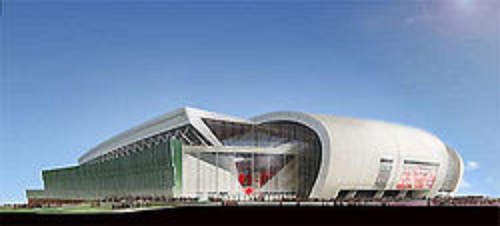 The cancelled Stanley Park Stadium
The cancelled Stanley Park Stadium
In July 2007 it was suggested that Liverpool FC could partially fund the reopening of this line to provide a direct rail link to their proposed new Stanley Park Stadium. If trains capable of use beyond the electrified network are selected as replacements, "then the case for bringing the Canada Dock Branch into passenger service operation will be examined". There is now suggestions to introduce passenger services on this line in the Local Transport Plan for Merseyside.
The Stanley Park stadium was cancelled with Liverpool FC extending their existing football ground. The Canada Dock Branch line has many merits for passenger serving Liverpool FC. A new large throughput station was suggested, however city planners are reported to be cold on any stadium expansion over 60,000, with a large throughput station as a precursor. A station on the line near to Liverpool FC would have football fans change at Edge Hill or Lime Street Station for the Manchester and London lines. Or change at Lime Street Station or Kirkdale station for Merseyrail connections. All seamless on Merseyrail. Unfortunately, any station built on the Canada Dock Branch line would not be adjacent to the stadium. Accessing the station would be a long walk amongst local houses.
Only full electrification and re-opened passenger stations merged into the Merseyrail metro network will ensure the line can cope with the near 60,000 capacity.
Outer Loop Line
 Mothballed Outer Loop Line has bridges still intact awaiting reuse, but ignored for a cancelled tram scheme wasting yet more time and money
Mothballed Outer Loop Line has bridges still intact awaiting reuse, but ignored for a cancelled tram scheme wasting yet more time and money
The Outer Loop Line from Hunts Cross to Kirkdale via the Kirkdale to Rice Lane tunnel is awaiting recommission. This line adds many districts to rapid-transit Merseyrail. If a football stadium is built at Walton Hall Park, as an adjacent Merseyrail station can give a high throughput to move fans in and out very fast. 30,000 to 40,000 fans per hour can be moved in and out of the stadium, reducing nuisance value to local residents and reducing road traffic jams. This would also increase the appeal of the stadium.
The setup covers much of what trams were to cover and shifts people fast with connections all over Merseyside. It is cheap to implement using existing mothballed rail infrastructure as most is actually in place. This gives a big bang-for-buck.
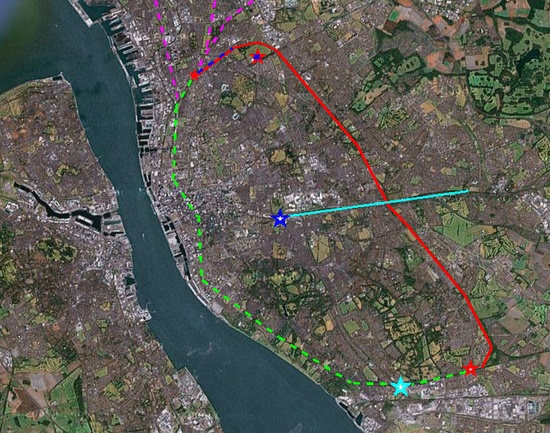 The Outer Loop Line completes a full city circle line
The Outer Loop Line completes a full city circle line
The map above:
-
The red is the proposed recommissioned Outer-Loop line - still with trackbed and bridges intact. This brings on-line: Walton Hall Park, Norris Green, Clubmoor, West Derby, Knotty Ash, Broad Green, Childwall, Gateacre, Woolton & Halewood - eventually. The catchment area of the line is substantial.
-
The red star at the top at the end of the red line is Kirkdale station.
-
The red star at the bottom of the red line is Hunts X station.
-
The red/blue line is the Kirkdale-Rice Lane tunnel.
-
The red/blue star at the top is Walton Hall Park where a football stadium could be built with a high throughput station. Trains leave the stadium both ways.
-
The green dotted line is the existing Northern line that creates a full city loop with the Outer-Loop - trains can just go around the loop, as they partially do on the Wirral Line. Or just around the loop on matchdays to shift fans from the stadium.
-
The pink lines are existing Northern Lines to: Southport, Ormskirk and Kirkby.
-
The light blue line is Edge Hill to the west and where it meets the red line is Broad Green. This could be made into a junction, as was planned to be so in the 1970's. That means the north and southern sections of the Outer-Loop can be two separate loops and will run right into Edge Hill junction and onto Lime St, or into Central if the Wapping tunnel is branched into Central station. Or down the Waterloo tunnel and onto the Northern Line at Waterloo Dock. All in the future, but would make the loop quickly accessible to the city centre.
-
The light blue star at the bottom is Liverpool South Parkway station with connections to London and Manchester and beyond.
-
The rails already bought for the collapsed Merseytram scheme are stored in Hull and can be used for the loop offsetting some costs.
Outer Stations Form Local Transport Hubs
Strategically located stations on the outer parts of the Merseyrail system can form local transport hubs. Hybrid/electric tram-like bendy-buses can operate from the rapid transit Merseyrail stations and serve the local districts. There appears no need to run expensive to implement trams from the centre to the districts not served by Merseyrail. Buses only need to operate from the nearest outer suburb Merseyrail stations, as occurs in London. The transport system can be integrated to compliment the various transport modes with seamless computer ticketing.
We don't need dreaming of over expensive outdated tram systems and other inappropriate projects - having modern looking full glass fronted trams is still trams. They were dropped by the city 50 years ago for good reasons and the reasons are still valid today. We need to see the proper positive socio/economic impact such a rapid transit underground extension(s) can give to the people of the Liverpool City Region. Trams partially plug a gap that can be filled by modern hybrid/electric tram-like bendy-buses, which were not available when the scheme was devised. The big gap in rapid-transit services by an extended Merseyrail.
St. Helens and the South End Lines Access Centre
 The Value Added by a Circle Line is Evident If the Circle Line is built, the electrified St Helens Merseyrail Line would enter Edge Hill and then drop down the Waterloo Tunnel and continue around the Circle Line and back up to Edge Hill and out again back to St Helens. This gives direct access to Liverpool Waters, Moorfields (business sector), South Docks, Central (shopping) and all other stations along the route without changing. Trains run into Liverpool centre, loop around the main districts and then back out. One change for Wirral and one for Liverpool John Lennon airport. The Circle line makes this possible.
The Value Added by a Circle Line is Evident If the Circle Line is built, the electrified St Helens Merseyrail Line would enter Edge Hill and then drop down the Waterloo Tunnel and continue around the Circle Line and back up to Edge Hill and out again back to St Helens. This gives direct access to Liverpool Waters, Moorfields (business sector), South Docks, Central (shopping) and all other stations along the route without changing. Trains run into Liverpool centre, loop around the main districts and then back out. One change for Wirral and one for Liverpool John Lennon airport. The Circle line makes this possible.
The same maybe possible with a south end city loop. Re-use the trackbed from Halewood to Broad Green, constructing a branch into the line heading for Edge Hill at Broad Green, and a loop is formed - this was planned in the 1970s. Along the Northern Line to Hunts Cross, Gateacre, Childwall, Broad Green, Edge Hill and into the centre via the Waterloo Tunnel and back again.
So three loops, north end, south end and St. Helens. All using this outer city centre Circle Line as the mechanism. This Circle Line is the core and must be the next transport project in Liverpool, transforming Merseyrail a true metro system.
Rapid Transit Required Linking Skyscrapers
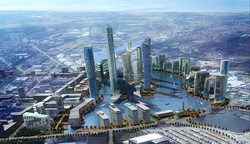 Wirral Waters
Wirral Waters  Liverpool Waters Merseyrail rapid transit is essential to ensure the success of Liverpool Waters and Wirral Waters. They require direct Underground rail access to: Liverpool city centre, to each complex and to Liverpool John Lennon airport. There are no firm proposals to run rapid transit rail into the two complexes.
Liverpool Waters Merseyrail rapid transit is essential to ensure the success of Liverpool Waters and Wirral Waters. They require direct Underground rail access to: Liverpool city centre, to each complex and to Liverpool John Lennon airport. There are no firm proposals to run rapid transit rail into the two complexes.
Liverpool Waters
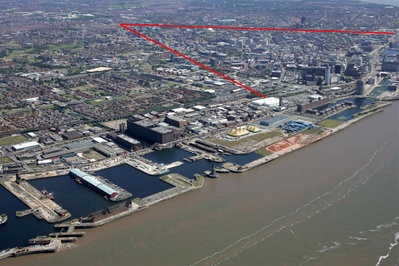 Waterloo Tunnel to the left - Wapping Tunnel to the right There has been no formal plan to run rapid transit rail into the Liverpool Waters complex. Peel, the developers were talking about reusing the Waterloo Tunnel which emerges at West Waterloo Dock, to run a monorail to Liverpool John Lennon Airport.
Waterloo Tunnel to the left - Wapping Tunnel to the right There has been no formal plan to run rapid transit rail into the Liverpool Waters complex. Peel, the developers were talking about reusing the Waterloo Tunnel which emerges at West Waterloo Dock, to run a monorail to Liverpool John Lennon Airport.
The Waterloo Tunnel runs from Edge Hill and emerges at West Waterloo Dock adjacent to the Merseyrail Northern Line. The Merseyrail Northern Line runs parallel to the River Mersey inland from the dock complex, however Sandhills station is too far from Liverpool Waters. It would be possible to branch from the Northern Line into the Liverpool Waters complex running at ground and elevated levels. However light rail carriages, similar to used in the London Docklands Light Railway, would almost certainly be necessary rather than the large Merseyrail heavy rail carriages - both types of carriage can use the same tracks. A station could be built at the Waterloo Tunnel portal, giving access to the Northern Line. A more ambitious plan to create a Liverpool city centre Circle Line using disused tunnels and stations merging Liverpool Waters into the system would be of great benefit to the complex and the city as whole.
A disused tunnel exists from Sandhills, on the Northern Line, to Wellington Dock very near to the proposed Liverpool Waters. There are prospects to reuse the tunnel to give access to the complex.
Liverpool Waters to be a success requires a rapid transit rail system to link to all of Merseyside and direct to:
- Liverpool city centre
- Wirral Waters
- Liverpool John Lennon Airport
Rapid-transit rail was considered essential for the success of London's Docklands. Without it Dockland would have been still-born. The same would apply to this project.
Wirral Waters
Complex Needs Merseyrail Station
This proposed skyscraper complex needs a Merseyrail rapid transit station to promote the project and connect the complex to Liverpool city centre, main line Lime Street Station and Liverpool John Lennon airport as well as all other parts of Merseyside.
Birkenhead Dock Branch Line Ideal for Wirral Waters
Merseyrail Birkenhead Central station is located in a cutting with a tunnel either end of the station. Running south the tunnel opens up to Green Lane Merseyrail station. The next station south is Rock Ferry. At Rock Ferry the Birkenhead Dock Branch Line, which is disused since 1993 and still has lines intact, branches off running north towards Birkenhead Docks. It emerges at the eastern end of the docks at Egerton and Morpeth Docks, exactly where the Wirral Waters complex is proposed. The dock branch line runs through a deep cutting and through the Haymarket tunnel, directly through the centre of Birkenhead.
There was official rumblings of using EU money to re-instate a freight line to Birkenhead Docks. The docks can be accessed via the Birkenhead Dock Branch Line at the eastern end or via Bidston at the western end of the docks.
The Wirral Waters proposal will use the eastern docks of Vittoria Dock and East Float. The western dock, the West Float will still be commercial shipping. It makes sense to access the docks via Bidston in the west for freight rail traffic and not via the Birkenhead Dock Branch Line to the east, coming in from the south. The Birkenhead Dock Branch line is ideal for passenger use and should be reserved for this purpose.
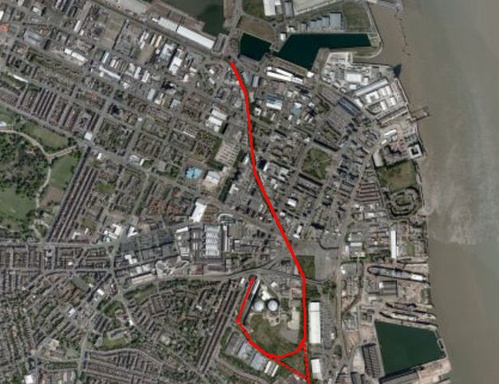 Disused Dock Branch can easily connect onto Merseyrail at Birkenhead Central
Disused Dock Branch can easily connect onto Merseyrail at Birkenhead Central
On the surface it appears the Birkenhead Dock Branch Line appears impractical as it runs south from the docks to Rock Ferry and only accessed via the south. However, the tunnel directly south of Birkenhead Central station running around the gas holders can be branched into and curved into the Birkenhead Dock Branch Line. This would be a very short section of new tunnel. Or raised up and onto the now demolished Mollington Street train maintenance depot. Light-rail trains can be used to reduce the arc of the U line. Merseyrail trains from Liverpool would run through Hamilton Square, Birkenhead Central and then do a U-turn and turn north onto the Birkenhead Dock Branch Line and onto Wirral Waters. A station could be built in the cutting at a suitable point if need be.
Birkenhead Dock Branch Line Cutting Ideal for Tunnel Conversion
The Birkenhead Dock Branch Line cuts right through Birkenhead centre. Such a deep cutting is a hindrance through a town centre. Precast concrete arches can be used to cover the line making a 4 track tunnel. Provision for a station may be left in the tunnel for future use. The whole cutting can be backfilled using the now massive trench as a lucrative landfill site. The resulting land may be sold off and developments built upon. Then Birkenhead is rid of a deep ugly gorge through its centre, and the profit from Landfill and land creation set against the cost of re-instating the line.
On the satellite photo, Birkenhead Central station is to the west of the round gas holders, bottom right - right next to them. The dotted lines are the Merseyrail track running south to Rock Ferry with the Birkenhead Dock Branch Line running south to Rock Ferry. The solid red is the Birkenhead Dock Branch Line running through the cutting and tunnel to Birkenhead Docks and Wirral Waters to the north. The solid red curve to the south of Birkenhead Central station may be a short length of tunnel, cutting or a ramp from one elevation to the other.
 The Birkenhead Dock Branch Line is in the cutting seen bottom left - the green line
The Birkenhead Dock Branch Line is in the cutting seen bottom left - the green line
Massive Potential of Underground
Merseyside could have a highly comprehensive underground/metro system, that could be extended even further using disused trackbed and stations - a full region-wide metro system. The potential for city regeneration and expansion is enormous. This is where focus and resources should be, not expensive to build needless trams and large out of the way stations. Priority is clearly Liverpool city centre and the inner-city districts. Schemes such as bringing Skelmersdale onto Merseyrail, although essential in the medium term, is not an immediate priority. The over £80 million estimated to construct this Skelmersdale line is better used in the city centre and inner-city and bring back into commission the disused city centre tunnels. This investment brings greater social benefits to the city of Liverpool and encourages investment.
Other cities would drool at having what Liverpool has waiting to be re-commissioned in rail infrastructure. Liverpool ignores it and goes off in inappropriate directions.
Does Merseytravel know what disused infrastructure is here waiting for re-use? Does Merseytravel know how to effectively connect this disused infrastructure onto Merseyrail? It appears not after putting forward a needless expensive tram project. It is about time Merseytravel were shaken up and and given meaningful priorities to aim for.
Links
Liverpool Skyscrapers Liverpool Waters Wirral Waters Liverpool's Historic Rail Tunnels Merseyrail http://myweb.tiscali.co.uk/watercity/Merseyrail-Extensions.html



